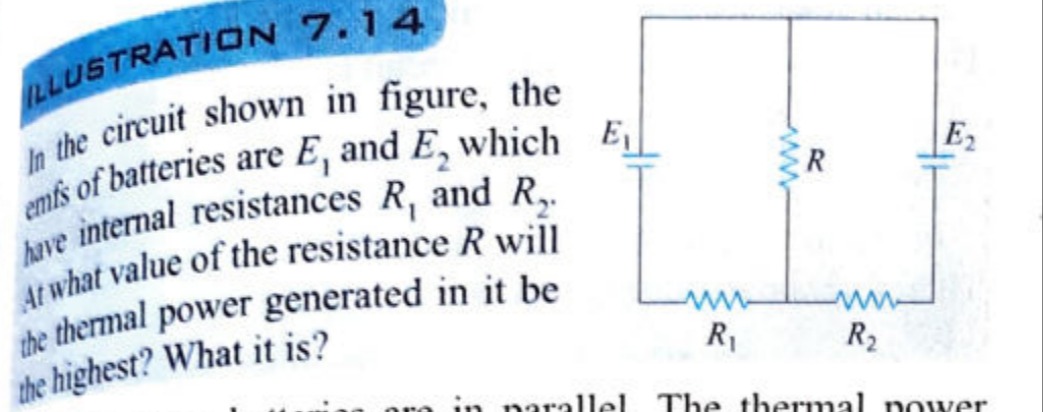Question
Question: In the circuit shown in figure, the emfs of batteries are $E_1$ and $E_2$ which have internal resist...
In the circuit shown in figure, the emfs of batteries are E1 and E2 which have internal resistances R1 and R2. At what value of the resistance R will the thermal power generated in it be the highest? What it is?

The thermal power generated in resistance R will be highest at R=R1+R2R1R2.
The thermal power generated in resistance R will be highest at R=R1+R2.
The thermal power generated in resistance R will be highest at R=R1R2R1+R2.
The thermal power generated in resistance R will be highest at R=E1+E2.
The thermal power generated in resistance R will be highest at R=R1+R2R1R2. The highest thermal power generated is Pmax=4R1R2(R1+R2)(E1R2+E2R1)2.
Solution
The circuit consists of two batteries with EMFs E1,E2 and internal resistances R1,R2 connected in parallel with an external resistor R. This configuration can be simplified by finding the equivalent EMF (Eeq) and equivalent internal resistance (Req) of the parallel combination of the two batteries.
The equivalent EMF of two sources in parallel with the same polarity is given by: Eeq=1/R1+1/R2E1/R1+E2/R2=R1+R2E1R2+E2R1
The equivalent internal resistance of two resistances in parallel is given by: Req=1/R1+1/R21=R1+R2R1R2
The circuit is now equivalent to a single source with EMF Eeq and internal resistance Req connected in series with the external resistor R. The current flowing through R is given by: I=Req+REeq
The thermal power generated in R is PR=I2R: PR=(Req+REeq)2R=(Req+R)2Eeq2R
To find the value of R that maximizes PR, we can use the maximum power transfer theorem, which states that maximum power is transferred when the load resistance equals the internal resistance of the source. In this case, the external resistor R is the load, and Req is the internal resistance of the equivalent source. Therefore, maximum power is generated in R when: R=Req=R1+R2R1R2
To find the maximum power, we substitute R=Req into the expression for the current: Imax=Req+ReqEeq=2ReqEeq Imax=2(R1+R2R1R2)R1+R2E1R2+E2R1=2R1R2E1R2+E2R1
The maximum thermal power generated in R is Pmax=Imax2Req: Pmax=(2R1R2E1R2+E2R1)2(R1+R2R1R2) Pmax=4R12R22(E1R2+E2R1)2⋅R1+R2R1R2 Pmax=4R1R2(R1+R2)(E1R2+E2R1)2
